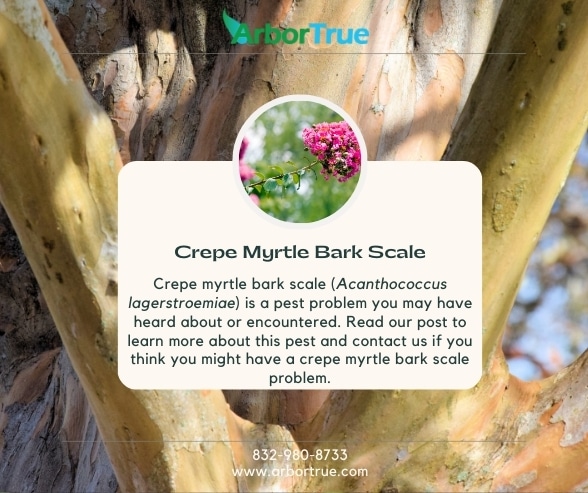
Mushroom Monday: Laccaria bicolor
April 29, 2024
Bacterial Leaf Scorch
May 3, 2024
Crepe Myrtle Bark Scale
Crepe myrtle bark scale (Acanthococcus lagerstroemiae) is a pest problem you may have heard about or encountered yourself. Read below to learn more about this pest and contact us if you think you might have a crepe myrtle bark scale problem.
What is Scale?
Although the word scale might make you think of something that might grow on a tree like a fungus, the word refers to a group of insects. There are thousands of insects in this group. Although their appearance and sizes vary, one thing they have in common is that they spend a portion of their lives under a covering that looks like a scale from a fish. The covers vary in their material, color, whether they are hard or soft, and shape, but they generally serve as a means of protection for the scale insects underneath. The covering serves as camouflage, helps keep the insects moist, and keeps them hidden from things that might eat them. The covering can also protect them from insecticides that work on contact. As they grow, the insects make their coverings larger. Generally, scale insects suck sap and other plant contents from plants.
How can Scale be Grouped?
Although there are thousands of scale insects, they can generally be grouped in two ways.
Some scale insects have coverings that are soft. These coverings are connected to the bodies of the insects under them. These insects can move with their scales. They eat sap from phloem in plants and they exude honeydew.
Other scale insects have a covering that’s hard. This covering is free from the body of the insect. These types of scale insects generally don’t move around once they are covered. They eat things from the cells of plants and they don’t exude honeydew.
What do Crepe Myrtle Bark Scale Insects Look Like?
Crepe myrtle bark scale are white/pinkish when they are adults and their eggs are pink. Their coverings are waxy and they excrete honeydew. They resemble mealybugs and are in the soft scale group of scale insects. The males have wings and fly to locate mates, and the females stay in one place once they are covered. The coverings for males and females look different.
Are Crepe Myrtle Bark Scale Native to America?
Crepe myrtle bark scale are not native to America. They came from Asia and seem to have come along with crepe myrtle trees. They were first noticed in the U.S. in the early 2000s in a suburb north of Dallas. They are now in a number of states.
What Does an Infestation of Crepe Myrtle Bark Scale Look Like?
When a crepe myrtle tree is infested with crepe myrtle bark scale, the branches of the tree can be completely covered with the scale, sometimes in layers. The covers are gray/white and will be found on larger twigs and the trunks of the tree, but generally won’t be on the leaves. They can be in larger groups where branches come together and where trees have been pruned. They can also hide under the peeling bark of trees.
What Problems do Crepe Myrtle Bark Scale Cause?
Although crepe myrtle bark scale generally don’t kill crepe myrtle trees, they can cause a number of problems.
First, they eat the phloem from trees, damaging them.
Second, they excrete honeydew that can cover trees. Black sooty mold can grow on this honeydew. This mold can turn the branches and trunks of trees black. Additionally, the honeydew can attract other insects such as ants and wasps. Black sooty mold can also be caused by aphids that excrete honeydew.
Third, infested trees can have less vigor, fewer flowers, leaves that come out later in the season, leaves that drop, bark that peels early, and dieback.
How can Crepe Myrtle Bark Scale be Prevented and Treated?
There are some ways to prevent crepe myrtle bark scale. They include checking trees for infestations before you buy them from plant nurseries, planting crepe myrtles in the proper way in places without shade, and keeping the trees generally healthy.
There are different treatments for crepe myrtle bark scale. If you think you might have an infestation, contact a qualified arborist. They can help identify the problem and let you know about treatment options available.
Are There any Predators for Crepe Myrtle Bark Scale?
Yes. Two examples are mealybug destroyers and lady beetles.
If you liked learning about crepe myrtle bark scale, check out the other posts on our TrueTreeTalk blog and follow us on Facebook to keep up with these and other posts. If you think you might have crepe myrtle bark scale, contact us to arrange an appointment. An arborist can let you know what could be right for your situation.
* * *
ArborTrue is a science-based tree-service company in the greater Houston area. We provide a range of services including tree trimming, tree pruning, tree removal, tree planting, arborist consultations, and more. Call us today at 832-980-8733 or reach out to us online to schedule an appointment.




